High-quality sleep is essential for your body’s natural detoxification processes and overall wellbeing. There are a lot of steps you can take to promote healthy sleep, and one of those is to reduce the amount of toxins in your environment!
When it comes to buying non-toxic bedroom furniture, knowing what to look for (and what to stay away from) can be a bit confusing. That’s why we’ve created this huge guide for you, where we will break down:
- What’s wrong with most conventional furniture brands
- What’s RIGHT about non-toxic and eco-friendly furniture brands
- And our picks for the best non-toxic and natural mattresses, bed frames, dressers, nightstands, mirrors, headboards, and benches.
Table of Contents
- What’s the Deal with VOCs?
- What’s the Difference Between Solid and Engineered Wood Furniture?
- Certifications to Look For
- GREENGUARD
- MADE SAFE
- Formaldehyde Free Verified by UL Environment
- Forest Stewardship Council (FSC)
- Sustainable Furnishings Council
- Non-Toxic Mattresses
- Non-Toxic Bedframes
- Non-Toxic Dressers
- Non-Toxic Nightstands & Bedside Tables
- Natural Headboards
- Natural Wood Mirrors
- Natural Wood Bedroom Benches
- Other Miscellaneous Storage & Decor
- Other Steps to Take for a Healthy Night’s Sleep
This article may contain affiliate links, which means we may earn a small commission if you choose to make a purchase. We only make recommendations that are genuine and meet our ingredient standards. Featured image credit: The Citizenry
What’s the Deal with VOCs?
When it comes to toxic furniture, the main concern is volatile organic compounds, or VOCs, which you can read more about here.
In short, VOCs are a group of chemicals that, due to their chemical composition, can easily evaporate into the air we breathe under normal atmospheric conditions. This evaporation is commonly known as “off-gassing.”
VOCs include chemicals like acetone, vinyl chloride, toluene, ethanol, and more. And a LOT of furniture manufacturers use these types of chemicals in their products. VOCs are used for things like:
- glues and adhesives
- foams
- fabrics
- chemical flame retardants
- paints, finishes, lacquers, varnishes
- and more.
The problem is that when these chemicals slowly off-gas from the furniture we buy and release toxins into your home, they can potentially cause negative health effects for the whole family—adults, babies, and pets alike.
Acetone, for example, which is commonly found in furniture polishes, has the potential to affect the hematological and neurological systems of the body. Formaldehyde, which is often used in the glues that hold the pieces of furniture together, can lead to everything from skin irritation to cancer.
This is why it’s important to consider purchasing from brands that use low- or no-VOC materials for their furniture, from the glues and foams, to the paints and finishes, and more. Look for brands that are skipping the chemical flame retardants, using non-toxic glues, and are finishing their eco-friendly furniture with natural oils.
What’s the Difference Between Solid and Engineered Wood Furniture?
Speaking of GLUE, did you know that much of the conventional furniture industry doesn’t even use real wood? Instead, they use pieces of wood and sawdust that have been glued together to look like real wood. This is called engineered wood, and it’s often listed under names like medium-density fiberboard (MDF), particleboard, plywood, or chipboard.
As you can imagine, it takes quite a bit of glue to turn wood chips and sawdust into something that looks like solid wood, and most of that glue contains formaldehyde, a known carcinogen. This is actually where a large portion of the VOCs in furniture comes from—it’s hidden in the wood!
That’s why you should always look for solid wood furniture (or even reclaimed wood furniture) whenever you can!
Certifications to Look For
Third-party certifications can be super helpful in making sure that brands are really doing what they say they are. Here are some common ones to look for when it comes to furniture:
GREENGUARD
The GREENGUARD certifications is administered by UL, and products with these labels “are scientifically proven to meet some of the world’s most rigorous third-party chemical emissions standards.”
The GREENGUARD Gold certification goes even further than its sister by including “health-based criteria for additional chemicals and also requires lower total volatile organic compound (VOC) emissions levels to ensure that products are acceptable for use in environments such as schools and health care facilities.”
MADE SAFE
MADE SAFE is a small, independent organization which verifies that consumer products are free from a long list of toxins. Their standards are pretty strict, so we like to see this certification!
Formaldehyde Free Verified by UL Environment
This certification is given out by the same organization that awards the GREENGUARD labels, but this one is focused specifically on whether or not a product is free from formaldehyde.
Forest Stewardship Council (FSC)
The Forest Stewardship Council, or FSC, doesn’t have so much to do with toxins as it does with how wood (and other plant-based materials, like bamboo) are sourced. Since the vast majority of non-toxic furniture brands use solid wood, it’s important to do our best to make sure that wood is sourced in a sustainable way that doesn’t contribute to deforestation. The FSC certification helps us do that!
Sustainable Furnishings Council
The Sustainable Furnishings Council isn’t actually a certification, but rather a membership organization. However, member companies still have to meet a certain set of requirements, so it’s still a good label to look out for. Whereas the Forest Stewardship Council (FSC) focuses just on wood and other plant-based products, the Sustainable Furnishings Council (SFC) takes more of a holistic look at the environmental footprint of a company’s entire production process.
Keep in mind that although these certifications are ideal, just because a brand doesn’t have one doesn’t necessarily mean its products contain toxic chemicals. These certifications can sometimes be costly, and it can be difficult for small, artisanal brands to work these costs into their tight budgets each and every year.
If you ever want more information about a brand’s sourcing, materials, pr production processes, don’t hesitate to reach out to them and ask!
And now, let’s get on to the specifics of each piece of bedroom furniture!
Home
9 Best Non-Toxic Furniture Brands for Your Healthy Home (2024)
In this guide, you’ll learn about what to look for in non-toxic furniture brands, and then we’ll give your our favorite brands to shop from that are using the safest non-toxic materials.
Non-Toxic Mattresses
If you’re going to choose just ONE piece of bedroom furniture to get in a non-toxic version, a mattress is probably the one! After all, it’s the one thing you sleep on every night (we spend about 1/3 of our lives in bed!) and are most likely to breathe in any chemicals that may off-gas from it.
You know those conventional memory foam mattresses that everyone has these days? Most of the time, that foam is made from petroleum-based materials such as polyurethane. This is not only bad for the environment, but it’s also toxic to the workers who make the mattresses as well as the consumers who buy them. Look for materials like organic or natural latex, organic cotton, and wool instead.
Typical mattresses also commonly contain other toxic materials like flame-retardants, synthetic latex, and adhesives that contain formaldehyde. All of these various ingredients and materials are potentially problematic for their own reasons. Look for materials like organic or natural latex, organic cotton, and wool instead.
The good news is that there are plenty of non-toxic and sustainable mattresses available on the market today, and you can check out our picks on our mattress guide right here. (Be very careful when mattress shopping because greenwashing is a huge problem in this sector of the industry!)
P.S. If you need some organic and non-toxic sheets and bedding to go on your mattress, check out this article.
Home
14 Best Organic & Non-Toxic Mattresses for Healthy Sleep in 2024
Conventional mattresses contain toxins that can cause health issues. If you’re considering a non-toxic mattress, here ‘s what to look for and our recommended brands.
Non-Toxic Bedframes
When it comes to a non-toxic bed frame, you’ll want to look for brands that use solid wood and natural/non-toxic finishes. You can check out our in-depth guide to non-toxic bedframes with our recommended brands right here.
Home
11 Best Natural & Non-Toxic Bed Frames for Sustainable Sleep in 2024
We rounded up 11 of the best natural wood or metal bed frames that are non-toxic, eco-friendly, free from VOCs, and other harsh chemicals. Slumber away!
Non-Toxic Dressers
When it comes to dressers, you want to look for the same exact things as bed frames: real, solid wood (instead of plywood, MDF, and other engineered wood) as well as natural and non-toxic finishes and paints. Check out our in-depth guide to dressers with our brand picks.
Non-Toxic Nightstands & Bedside Tables
Avocado

You’ll notice Avocado on just about all of our guides to a non-toxic bedroom. When it comes to sustainable sourcing and safe, high-quality materials, they’re one of the most trustworthy brands. Their products carry a handful of certifications, including FSC, MADE SAFE, Sustainable Furnishings Council, Carbon Neutral, Formaldehyde Free, GREENGUARD, 1% for the Planet, and more!
Avocado is super transparent about their sourcing, materials, and processes; customers can find an answer to just about everything they might want to know about their products right on the website. Everything is made by hand in their low-waste Los Angeles workshop and their manufacturing process is super sustainable.
They carry a few different variations of natural wood nightstands and end tables.
RELATED: Our Honest Review of the Avocado Eco Organic Mattress (After 1 Year of Use)
The Citizenry

The Citizenry’s beautiful nightstands and side tables are handcrafted out of natural materials like mindi wood, hinoki wood, and teakwood. Everything is ethically made in fair trade environments in places like Japan and Indonesia.
ducduc
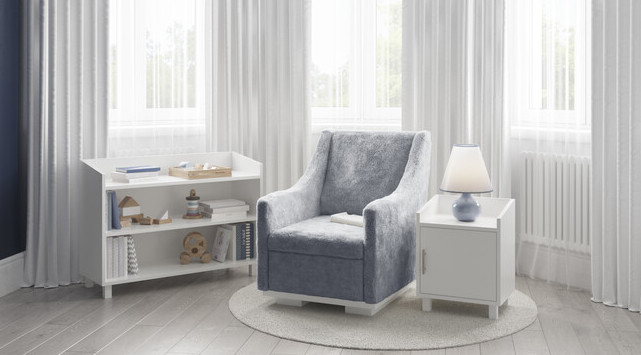
Although this brand isn’t exclusive for kids, ducduc does carry a great collection of non-toxic furniture that will go great in your nursery or kids’ room. It’s all made by hand in the USA out of 100% baltic birchwood (which is completely MDF-free), non-toxic glues, and water-based finishes.
Their nightstands come in colors like white, natural wood, grey, black, and midnight blue.
Masaya & Co.

Masaya & Co. carries several gorgeous mid-century nightstands built with sustainably harvested hardwood and a low-VOC natural oil finish. These bedside tables are sustainably made by artisans in Nicaragua, and each purchase plants 100 trees!
West Elm

West Elm carries a wide variety of nightstands and bedside tables in just about every aesthetic you can think of. Not all of them are non-toxic/sustainable, but many of them are! They make it easy to filter according to your priorities: Sustainably Sourced, Fair Trade, Handcrafted, Green Guard Certified, and more.
Thuma

Thuma carries a minimalistic wood nightstand with a drawer that complements their bed frame. It’s handcrafted out of real, repurposed wood without any MDF or veneers. Plus it has a cushioned cork bottom so it won’t damage your floors. It’s GREENGUARD Gold Certified, too!
Medley

Medley carries a few different nightstands that have very different aesthetics. Handcrafted in California, they use materials like Hard White Maple or American Walnut solid wood, eco-friendly bamboo, and water-based, low-VOC protective finishes. The hardware is customizable, too, so you can choose what would look best in your space.
Use the code THEFILTERY5 for 5% off your order.
Nest
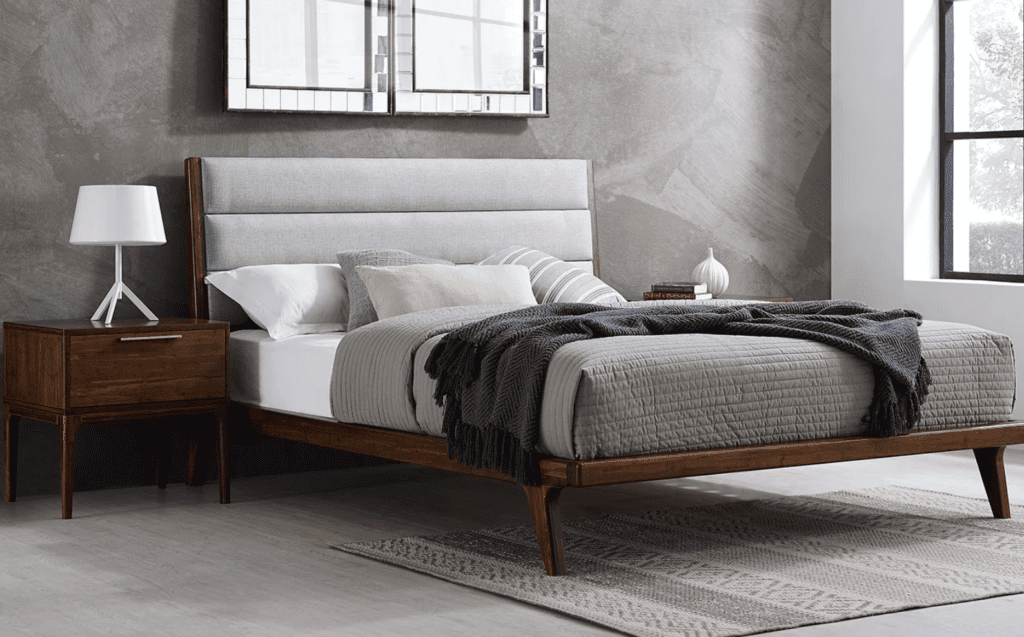
For a different option, you might want to check out Nest. Instead of regular trees, their nightstands (and dressers and bed frames) are made out of 100% solid Moso bamboo. (Bamboo tends to be a little more lightweight than solid wood.) They’re made in an ISO 14001 Environment Management certified facility without any plywood, particleboard, or MDF.
For nightstands, they have two different collections: the Mercury (pictured above) and the Azara (which is available in two colors and has a more mid-century aesthetic). Both nightstand designs have one drawer/cabinet.
Natural Headboards
Wooden headboards often come with the same issues as bed frames and other wooden bedroom furniture: they’re made with engineered wood and therefore contain a lot of adhesives and formaldehyde.
Upholstered headboards can also be an issue because they often contain foams, which are made out of synthetic foams, which commonly contain a lot of plastics and VOCs as well. (Although, there are a few better alternatives for upholstered headboards.)
Some non-toxic bed frames come with headboards, but if you want or need to buy one separately, here are some brands that carry beautiful, natural, and non-toxic headboards:
The Citizenry

If you’re looking for a bohemian vibe, check out The Citizenry’s headboards. These are handcrafted in Malawi and Indonesia in a fair trade environment out of natural rattan and zero finishes.
KAZI

These gorgeous sustainable headboards from KAZI are made by artisans in Ghana out of natural elephant grass and organic dyes. They come with the Nest Seal of Transparency, which verifies that the artisans were paid a living wage for their work. These function not only as headboards but as pieces of art as well!
Medley
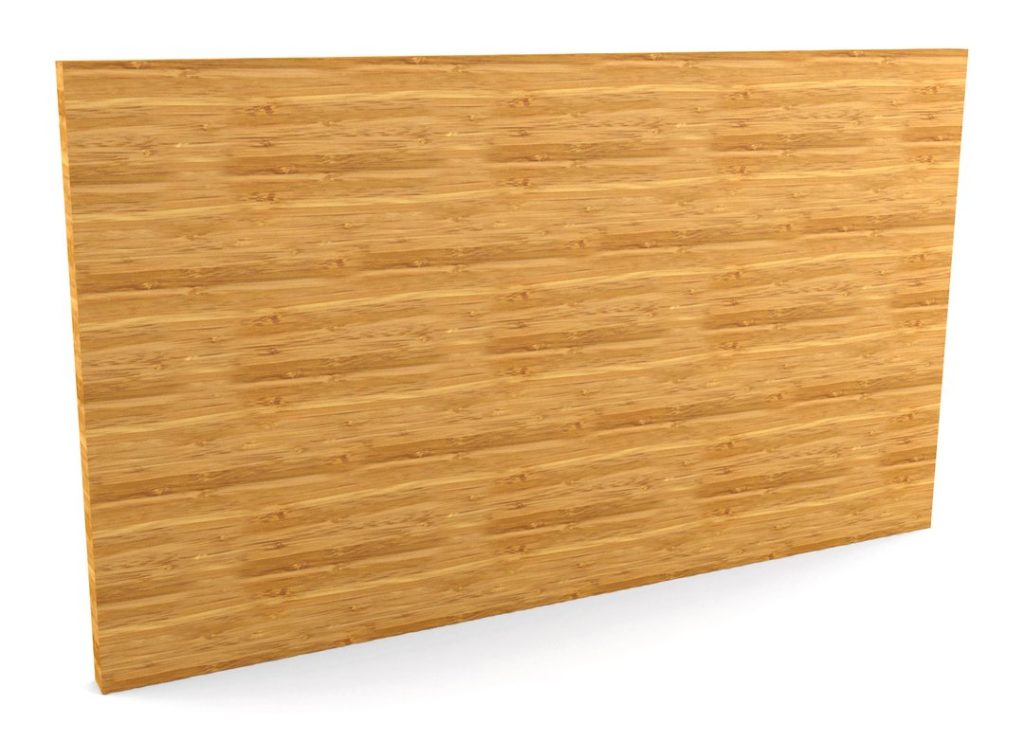
Medley carries a minimalistic bamboo headboard that comes in natural or amber. These are finished with a water-based, low-VOC protective matte clear coat. They also carry an upholstered headboard, if you REALLY want one of those. It’s made with poly foam, so it’s not completely natural, but it is certified by CertiPUR-US®, which is definitely better than nothing!
Use the code THEFILTERY5 for 5% off.
West Elm

West Elm has a wide variety of options, so they can also be a pretty good place to find headboards and other bedroom furniture that’s less toxic than conventional brands. Most of their headboard options aren’t perfect, but they do use a lot of natural, recycled, and GREENGUARD Certified materials. Just make sure you check the details before purchasing to make sure the materials meet your personal standards.
Natural Wood Mirrors
The Citizenry

The Citizenry carries several different types of mirrors, including a beautiful floor mirror that’s handcrafted in Japan by a 4th generation fair trade workshop comprised of 33 artisans (each mirror takes over 10 days to complete!). They use the highest-grade hinoki cypress solid wood.
Kalon Studios
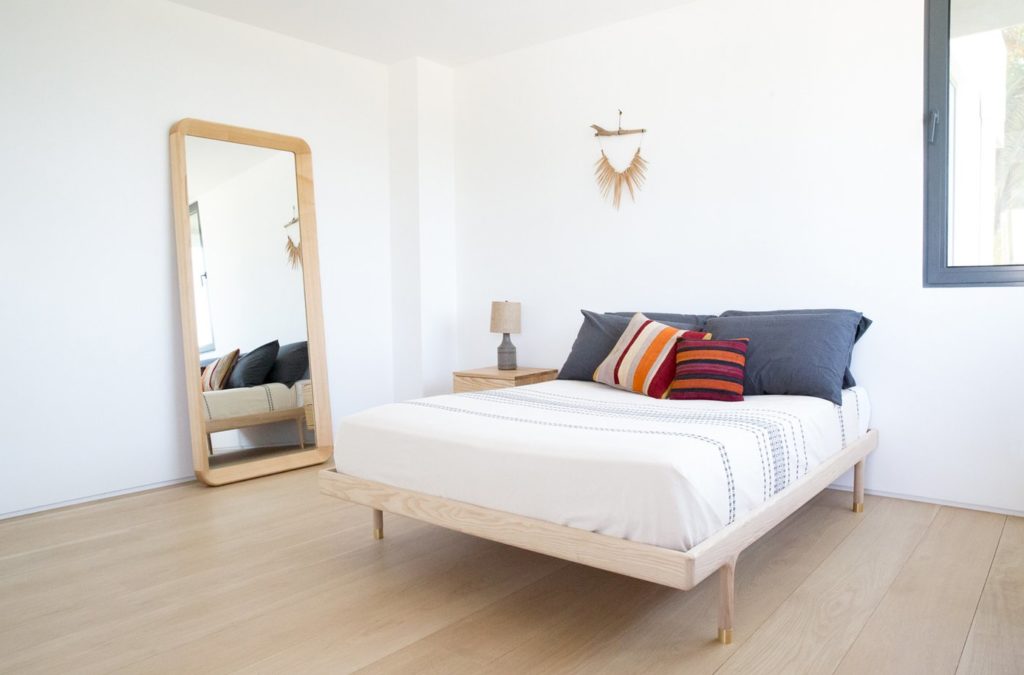
This “Simple Mirror” can be a freestanding or hanging mirror for your bedroom. It’s made with a solid, domestic Ash frame and finished with zero-VOC and formaldehyde-free hemp seed oil (although it does have a plywood back panel).
West Elm

West Elm can also be a great place to find sustainable and fair trade floor mirrors. Some are made from non-toxic and eco-friendly materials like FSC and GREENGUARD Gold Certified wood, while others aren’t—so again, just make sure to check before purchasing!
Natural Wood Bedroom Benches
Avocado

Avocado carries a very simple solid wood bench, which can be placed at the end of your bed, or pretty much anywhere else in your home! Handmade in Los Angeles out of solid maple, it carries the same certifications as the rest of Avocado’s products: FSC, GREENGUARD, Formaldehyde-Free, Sustainable Furnishings Council, Climate Neutral, etc.
Kalon Studios

Kalon Studios carries some unique benches, like their unfinished trunk bench. Everything is made in the USA out of solid wood.
Masaya & Co.

Masaya & Co. also carries several different thin benches which would fit well at the end of your bed. They’re all handcrafted by artisans in Nicaragua out of sustainably harvested teak hardwood and a low-VOC natural oil finish. Plus, 100 trees are planted with each purchase. If you’re looking for a more colorful option, check out this one!
Etsy

Etsy can be another great place to find non-toxic bedroom furniture and decor made from natural materials—like this super cute lemon wood and braided rope bench!
Other Miscellaneous Storage & Decor
When it comes to other miscellaneous storage (like baskets) and decor for your bedroom, Made Trade, The Citizenry, Etsy, The Little Market, Obakki are some great conscious shops to check out.
Stay tuned for a full guide into non-toxic and natural home decor—coming very soon!
Other Steps to Take for a Healthy Night’s Sleep
In addition to getting non-toxic furniture, here are some other steps you can take to cultivate a non-toxic sleeping environment.
Organic & Non-Toxic Bedding
The next time you’re in the market for new sheets, consider choosing bedding that’s made from organic fibers and non-toxic dyes. Check out our full bedding guide complete with our recommended brands here.
Home
9+ Best Non-Toxic Bedding & Organic Bed Sheets in 2024
You spend a lot of time in bed! So to foster a healthy bedroom environment, consider choosing non-toxic bedding. Here are my favorite organic bedding brands in 2023!
Clean Air
Air purifiers can help immensely when it comes to decreasing indoor air pollution—especially that which comes from the off-gassing of carpet, building materials, and conventional furniture! When it’s nice outside, consider opening the windows for a while in order to get some fresh air circulating—it’s an easy and free way to improve your indoor air quality quickly! Consider purchasing a high-quality air purifier. AirDoctor is the one I use (and you can get $300 off with this link).
Non-Toxic Carpet
This can be a difficult one, especially if you rent. Most conventional carpets contain VOCs. If you’re a homeowner in the market for new carpet, consider purchasing from a brand that uses safe, natural materials. Earth Weave is a great option. Alternatively, you could go with wood flooring and a non-toxic rug instead.
If you’re renting or just not replacing your carpet right now, don’t worry… Focus on what you can control and try not to stress too much about the rest! If the carpet is new, take an extra effort to air out the room by opening the windows and running an air purifier. Remember, newer furniture and building materials tend to off-gas a greater amount of VOCs.
We’re working on a full guide to non-toxic carpet as well, so be on the lookout for that soon!
Safe Paint
Paint also tends to have a lot of VOCs in it. As with the carpet situation, you may have more or less control over this depending on if you rent or not. Don’t stress if you’re not allowed to paint—again, just focus on what you can control!
But if you are planning to repaint your bedroom or other rooms in your home soon, this can be a great opportunity to reduce the amount of VOCs by choosing a non-toxic or less-toxic brand of paint, such as Ecos Paint. Stay tuned for our non-toxic paint article for more details!
Mindful Lighting & Screentime
“Toxins” can come in a lot of different forms; it’s not just about chemicals! There are so many things that can affect your quality of sleep (and therefore your overall quality of life!) for the better or worse.
You can work on improving your sleep by reducing your amount of screen time (phones, TVs, tablets, etc.) before bed and/or wearing blue light blocking glasses since blue light can disrupt healthy hormone function and negatively affect your sleep.
You also may want to consider reducing your caffeine consumption during the day (particularly after noon), reducing stress, and developing a relaxing nighttime routine that includes things like a hot bath, yoga, and/or herbal tea.
Organic Pajamas
Lastly, pajamas made from natural and organic fabrics, water-based dyes, and zero flame retardants are a good step, too! You can check out our guide to the best organic PJs for the whole family right here.
Kids
The 17 Best ORGANIC PAJAMAS for the Whole Family [2024]
Wearing non-toxic and organic pajamas is one small thing you can do to cultivate a healthy sleep environment for yourself and your family. We’ve researched and rounded up the BEST organic sleepwear brands for everyone in the family.
When it comes time to upgrade your bedroom and switch out your furniture, skip the polyurethane foam mattresses, MDF wood, and toxic flame retardants, and instead shop from brands that prioritize healthy materials that are better for human AND planetary health. And if we missed your favorite non-toxic bedroom furniture brand, feel free to let us know in the comments and we’ll check it out!
To get more product recommendations, stay up to date on environmental toxin news, and more, sign up for our weekly newsletter.





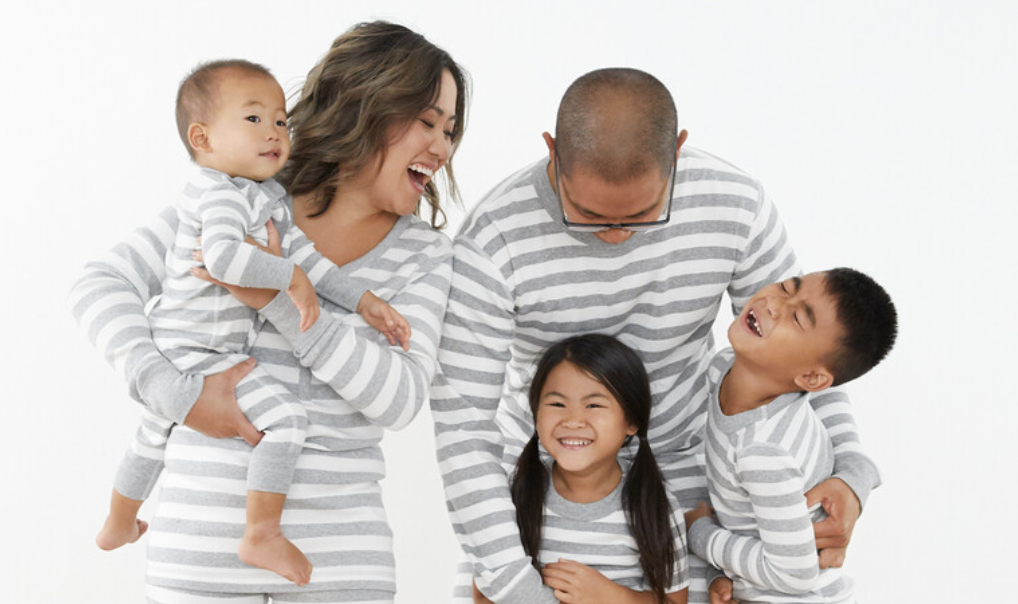




Hi. Thanks for your helpful website. Please share your thoughts on Amish furniture. Amish pieces check the bix for solid wood with no/very little glues etc., but a stain (unclear if water or oil based) and then a “conversion varnish” are both applied to color and protect the wood. The varnish is clearly high VOC/formaldehyde, as well as carrying a CA Prop 65 warning specific to something called Toluene. There will of course be some variation among manufacturers, but the conversion varnish is the customary practice and gold standard.
So what are we to do? Real wood with highly toxic varnish and stains, or MDF or engineered wood that is not varnished? The latter obviously gets thrown in the landfill after a short time.
It is not economically feasible to fill your home with products like Medley or Avocado that cost several thousand dollars more per piece than the other alternatives.
Hi JB,
I think Amish furniture can be a good option and that you’re totally right that it can vary by manufacturer… Although it’s not always the case, I think that a lot of times, Amish furniture craftspeople are more open to customization than ‘regular’ brands. So honestly, I would recommend reaching out to a couple of Amish furniture brands around you and just asking them if they can make the piece you want to buy either without a finish on it, or with a natural finish like linseed oil. I bet you could relatively easily find someone who would be more than willing to do that for you!
You made a good point that it’s important to also look into whether the part of my furniture are non-toxic. I’d like to find a good custom wood bedroom set soon because I’ve been thinking about buying a new bed for some time now. I think it would be better to just change up the whole bedroom at this point.